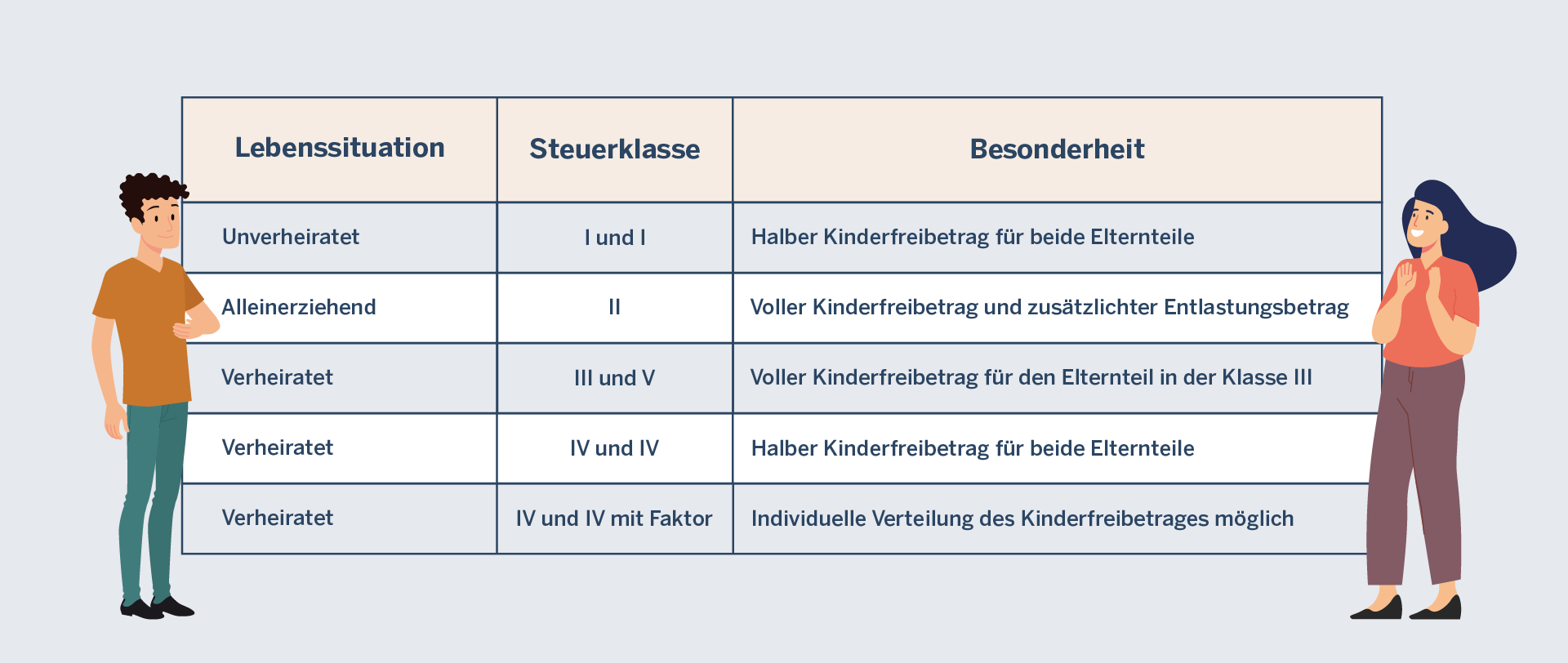Tax classes
All tax brackets for families explained simply
Which tax bracket is best for married couples with children? Which tax bracket do single parents choose? What effect does a change of tax class have and when is it worth changing tax class?
Many questions about the choice of tax class cannot be answered in general terms. The optimal combination depends on the parents' life situation and income. Read here to find out which income tax bracket is right for you.

Explanation of the tax classes
When their life situation changes, for example when they get married or start a family, couples are faced with the question: What tax brackets are there? And what do we need to consider?
There are six different tax brackets in Germany. Which tax bracket you are assigned to depends on your marital status and income situation.
In contrast to single people, married couples or registered civil partnerships who pay income tax have leeway when choosing their tax bracket. The tax bracket influences the monthly wage tax deduction, but also, for example, the amount of unemployment, sickness, parental and maternity benefits.
There are tax classes 1-6, which we present here for an initial overview. A note on this: In public administration, the tax brackets are numbered consecutively using Roman numerals. However, we also use Arabic numerals in the text, which are also commonly used.
-
Tax bracket 1: Single person
Employees are assigned to tax class 1 if they
- are single
- are married but live permanently separated for the whole year
- are divorced
- are widowed (after one year has passed since the death of their spouse)
Couples who are not married to each other and have a child together are also assigned to tax class 1.
-
Tax class 2: Single parents
If you live separately and are a single parent, you can switch to tax class 2. This has the advantage that an additional relief amount for single parents is taken into account.
The prerequisite for choosing the more favorable tax class 2 is that at least one minor child lives in your household for whom child benefit or a child allowance is claimed.
However, if you are in a marriage-like relationship or a registered civil partnership, you cannot be assigned to tax class 2. In this case, the allocation to tax class 1 remains. -
Combination of tax class 3 and 5 for married couples
The choice of tax class 3 is only possible if the other partner chooses tax class 5 or is not employed.
The combination of income tax class 3 and income tax class 5 is worthwhile if one of the two partners earns significantly more than the other (income ratio of 40 to 60 percent or more). The higher-earning partner chooses tax class 3, while the other partner chooses tax class 5.
This combination means that the higher income in tax class 3 is taxed at a lower rate. The partner in tax class 5, on the other hand, has significantly higher tax deductions from wages. In total, the tax combination 3/5 can lead to a higher net income. -
Tax class 4
Employees who are married or in a registered civil partnership are automatically assigned to tax class 4 by the tax office and therefore pay roughly the same amount of tax as single people. If both partners have roughly similar incomes, this makes sense, as tax class 4/4 means that both incomes are taxed equally. If you would like a different distribution, you must apply to the tax office.
-
Tax class 4 with factor:
The tax class combination 4/4 with factor is ideal if the income is different and the aim is to distribute the income tax burden fairly: Each spouse then pays the proportion of income tax that they also contribute to the joint income. The factor is valid for up to two years and must be applied for at the relevant tax office.
-
Tax class 6
Tax class 6 applies to all employees who have a part-time job in addition to their main job. Tax class 1, 2, 3, 4 or 5 is selected for the main job, while tax class 6 automatically applies to the part-time job.
This is where the higher taxes apply, as no allowances are taken into account. Tax class 6 is ideal for part-time jobs if the main job is already in a different tax class.
Tips on the best choice of tax class for families
Choosing the right tax bracket can result in you having fewer tax deductions each month. You should therefore regularly check whether your tax bracket is still correct. Here are some tips that can help you choose the best tax bracket for your financial situation:
- Life is constantly changing. A job change, marriage, the birth of a child and other personal or family changes can lead to a new income situation. You should therefore regularly check your income situation: What is your current gross income and that of your partner? Are you (still) in the right tax bracket? Is it worth changing tax bracket to save tax?
- If one partner earns significantly more than the other, the tax class combination 3/5 may be more favorable. The higher-earning partner chooses tax class 3, while the lower-earning partner chooses tax class 5. This reduces the financial burden on the higher-earning partner and therefore results in a higher monthly net income for the family. However, you should also bear in mind that the high taxation of the employee in tax class 5 can have undesirable side effects.
- If you live separately and are a single parent, you should switch to tax class 2 if the requirements are met. This will allow you to claim the additional relief amount. This will reduce your tax burden and you will have a higher monthly net income.
- If necessary, seek advice from tax experts who can recommend the best tax bracket for you.
Tips on the best choice of tax bracket for single parents
If you are unmarried, divorced, widowed or permanently separated and have at least one minor child living in your household, you can save a lot of money with tax class 2. Due to the relief amount for single parents, you have fewer deductions and therefore receive a higher net salary. Please note:
- If your child is registered with both parents, the parent who receives the child benefit or claims the child allowance receives the tax relief amount.
- The relief amount is linked to the child benefit or child allowance. If you continue to receive child benefit after your child's 18th birthday or use the child allowance because your child is still in education or studying, you can continue to claim the relief amount.
- You only receive the relief amount on condition that you live alone in the household with your child or children. There must not be another adult registered there. The tax office will only make an exception if you look after a person in need of care in your household.
- You must assure the tax office that you meet the above requirements. If your living situation changes, for example if a new partner moves into your household, you must inform the tax office immediately.
- In order to benefit from the tax advantage of income tax class 2, you must apply for the change yourself at your local tax office. The tax relief amount will then be credited automatically and you will pay less tax each month.
- If necessary, seek advice from tax experts who can recommend the best tax class for you.
Change income tax class: how it works
If there are changes in your life or income situation, you should check whether it is worth changing your tax class. You can apply to the tax office to change your tax class by November 30 each year. The application for a tax class change will then take effect in the same year. The application must be submitted to the local tax office. You can find out how to change your tax class here:
- A tax class change is possible once a year. In special cases, such as marriage, the birth of a child or separation, the change can also be made several times a year.
- To change income tax class, fill out the form "Application for tax class change for spouses" or "Declaration of permanent separation". You can use the online portal "My ELSTER" and complete the application digitally. Alternatively, you can obtain the forms from your tax office or download the applications online. You can access the application for a tax class change via the Federal Tax Administration's form management system. The link is www.formulare-bfinv.de.
- If you change your income tax class due to marriage, the birth of a child or separation, you must enclose the relevant evidence with your application for a tax class change. Here too, you can submit the application via the online portal "My ELSTER" or submit the completed tax class change form with the required evidence by post to your local tax office.
How does the tax class affect the child allowance?
If you have a child, this does not usually affect the tax bracket itself. However, the entitlement to the child allowance reduces the amount of income tax. The distribution of the child allowance depends on which tax bracket you are in:

Summary of the most important points and recommendations for families
The choice of tax class can have a significant impact on your monthly net income. If you are married, you should check whether the combination of income tax classes 3/5 or 4/4 is more suitable for you. If you are a single parent, you can benefit from the advantages of income tax class 2. If your life or income situation changes, a change of tax class can bring financial benefits, especially for married couples and single parents. You should apply for a tax class change in good time.
WHERE CAN WE FIND HELP AND ADVICE?
You can find detailed information on income tax classes and answers to frequently asked questions about choosing the right income tax class on the portal of the tax authorities for North Rhine-Westphalia.
You can find your local tax office and contact details using the tax office finder "Mein Finanzamt".
The application for tax class change for spouses/life partners is available to download from the Federal Ministry of Finance web portal. Alternatively, you can also create the tax class change electronically via "MY ELSTER".


